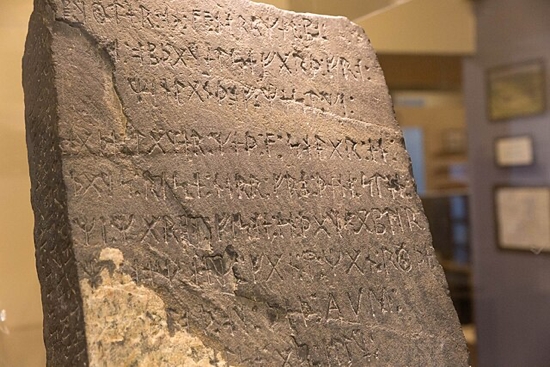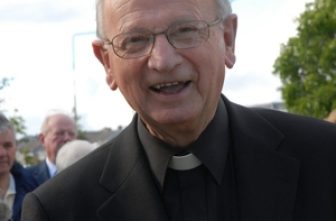
Some 130 years before Christopher Columbus sailed across the Atlantic, America may have been visited by other Catholic explorers. They may have traveled to, of all places, what is now Douglas County in west-central Minnesota. Our Lady of the Runestone Church in Kensington — the world’s only church with this name — is a testament to a unique and enigmatic piece of Minnesota’s Catholic heritage.
In 1898, Swedish immigrant farmer Olof Ohman was clearing an old tree on his farm near Kensington when he found something remarkable. Wedged deep in the roots was a large flat stone covered on one side with ancient Norse runes. It was an account of a journey by 30 Norsemen who arrived in the area in 1362. The stone commemorated 10 of the explorers’ companions whom they had found “red with blood and dead.”
Some speculate that the Norsemen, skilled navigators who had already established themselves in Newfoundland and Greenland hundreds of years earlier, could have traveled across Hudson Bay, through modern-day Manitoba by lake and river, and into Minnesota via the Red River.
The Kensington Runestone, as it came to be known, became a source of fascination and controversy around the world. One line of the strange text, however, proved especially interesting to Catholics. After recounting the discovery of the fallen explorers it reads, “AVM, save us from evil.” The letters “AVM” stand for “Ave Virgo Maria,” or “Hail Virgin Mary” in Latin. The title “Our Lady of the Runestone” refers to Mary not as she appeared in any particular apparition, like Our Lady of Lourdes in France or Our Lady of Guadalupe in Mexico. It refers instead to the Blessed Mother as called upon by the runestone explorers during their hour of need. It is the only Marian title originating in Minnesota.
While opinions on the runestone are divided, many researchers consider it a fake. Despite the ridicule Ohman and his family faced, though, he insisted to his dying day that he did not forge the stone.
As David Krueger explains in his 2015 book “Myths of the Rune Stone,” some Minnesota Catholic leaders, including Archbishop John Ireland, found the story, if not fully convincing, at least worthy of interest and consideration.
In his 1952 history “The Catholic Church in the Diocese of St. Paul,” Msgr. James Michael Reardon wrote that the Norsemen’s visit “conferred baptism on the state by the shedding of Catholic blood” and that the runestone contained “the first prayer of which we have any extant account in the western world.” The runestone gave Catholics in predominantly Protestant Minnesota a historic claim to the land and reminded the state’s Scandinavians of the Catholicism of their forefathers.

At a 1957 dedication of a shrine to Our Lady of the Runestone at St. Mary School in Alexandria, Bishop Peter Bartholome of St. Cloud (who served as bishop from 1953 to 1968) encouraged those present to take up this distinctly Minnesotan devotion. During the planning for a new church in Kensington, he supported the name “Our Lady of the Runestone.” Mass was first celebrated there in the spring of 1964. Today, Mass is held on Sundays and Wednesdays at 8:30 a.m.
In addition to its historical significance, the little A-frame church has a warm community. “We have always felt more than welcomed as many people approach us and thank us for coming,” said Kay Keller, a member of St. Michael in Kenyon who has visited many times with her family on trips through the area. “We feel at home there, because we are members of a small parish.”
Just outside of nearby Sauk Centre is the “Viking Altar Rock,” believed by early runestone promoter Hjalmar Holand to be one of the sites where the Norsemen celebrated Mass. The original runestone is on display at the Kensington Runestone Museum in Alexandria.
If the story is true, it might mean that Minnesota has the honor of being the first place in the United States touched by the Gospel. It suggests that the first prayer, Mass and martyrdom all might have taken place in the state.
If it is not true, then, as Father John LaFarge wrote in his 1932 article “The Medieval Church in Minnesota,” it can still provide inspiration. If nothing else, it is a reminder to turn regularly in hope to the Blessed Mother who, 1362 journey or not, watches over and protects us by her prayers. This Jubilee Year, with its theme Pilgrims of Hope, reminds us that we too are pilgrims on a great adventure of life in Christ. Just as with Norse adventurers of old, our Mother cares for us through all the trials and uncertainties we meet along the way.




